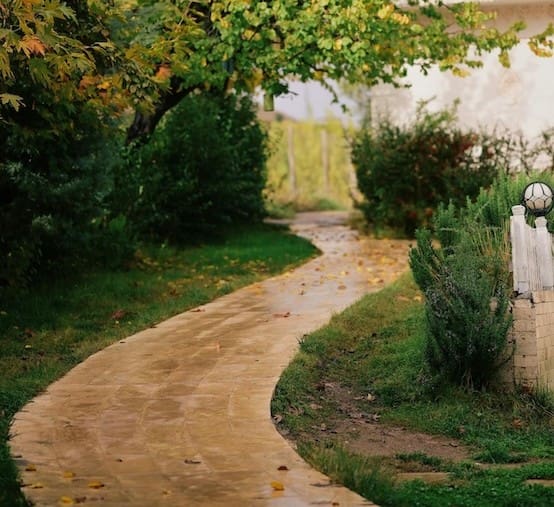Creating a Beautiful and Functional Pathway At Home With Backyard Trail Design
A backyard trail transforms your outdoor space into a scenic, inviting retreat. Whether you want a winding garden path, a rustic woodland trail, or a sleek modern walkway, the right backyard trail design enhances aesthetics, functionality, and property value. A well-designed trail:
- Providesaccess to different areas of your yard
- Improves drainage
- Blends seamlessly with your landscape
At Borst Landscape & Design, we specialize in custom landscape and backyard trail design that complements your outdoor space. Our expert team can help you create a beautiful, durable trail that suits your style and needs.
Call us today at (201) 785-9400 orcontact us onlineto start designing your dream backyard trail!
Planning Your Backyard Trail Design
Before breaking ground, thoughtful planning ensures your backyard trail is both functional and visually appealing. Consider these key factors:
Determine the Purpose of Your Trail
Are you designing a decorative garden path, a functional walkway, or a woodland hiking trail? Your purpose will influence the trail’s width, material, and layout.
Garden Path:Meandering design with stepping stones or gravel for aesthetics.
Functional Walkway:Straight, structured path leading to a patio, shed, or pool.
Woodland Trail:Natural, winding path that blends with the landscape.
Choose the Right Location
Evaluate your yard to determine the best trail placement. Look for:
Natural foot traffic patterns– Where do people naturally walk?
Elevation changes– Consider slopes and drainage needs.
Existing landscape features– Plan around trees, flower beds, and garden spaces.
Select the Best Materials
The right material impacts both the appearance and durability of your backyard trail.
Gravel:Budget-friendly and easy to install.
Flagstone:Natural, elegant, and long-lasting.
Brick or Pavers:Structured, classic, and low-maintenance.
Wood Chips or Mulch:Soft, natural look for woodland trails.
Stepping Stones:Perfect for meandering garden paths.
Step-by-Step Guide to Building a Backyard Trail
1. Mark the Pathway
Use spray paint, garden hoses, or stakes to outline the desired trail shape. Make sure the width suits its purpose:
18-24 inches– Small footpath or garden trail.
36 inches– Standard walkway width.
48+ inches– Wide, multi-purpose path.
2. Prepare the Ground
Clear the area:Remove grass, weeds, and debris.
Dig a base layer:Excavate 3-6 inchesfor stability and drainage.
Add landscape fabric:Prevents weed growth while allowing water to drain.
3. Lay Your Base Material
For gravel or stone paths, add a compacted base layer of crushed stone (about 3-4 inches deep). This ensures a stable, even surface and prevents shifting.
4. Install Your Trail Surface
For stone or pavers:Place each piece, ensuring a snug fit. Fill gaps with sand or gravel.
For gravel or mulch:Spread evenly and compact lightly.
For wood chip paths:Use edging to keep materials in place.
5. Add Edging & Finishing Touches
Wood, stone, or metal edgingprevents materials from spreading.
Low-voltage path lightingenhances safety and ambiance.
Native plants or decorative ground coversoften the trail edges.
There are many ways to create attractive edgingfor trails and gardens.
Designing a Sustainable and Low-Maintenance Backyard Trail
A well-planned trail should be sustainable, durable, and low-maintenance. Here’s how:
Use Permeable Materials:Gravel, mulch, and permeable pavers allow water to drain naturally, reducing runoff.
Choose Native Plants:Low-maintenance plants enhance your trail without excessive watering.
Install Proper Drainage:If water pools on the trail, use French drains or grading to prevent erosion.
Regular Maintenance:Refresh mulch, remove weeds, and check for uneven stones periodically.
Creative Backyard Trail Design Ideas
Looking for inspiration? Here are some unique backyard trail design ideas to get you dreaming of the possibilities:
1. Meandering Garden Path
✔ Curves gently through flower beds, trees, and shrubs.
✔ Use stepping stonesor gravelfor a natural look.
✔ Add solar-powered pathway lightsfor nighttime ambiance.
2. Rustic Woodland Trail
✔ Follows the natural terrainof your yard.
✔ Use wood chips, moss, or flagstonesfor a natural feel.
✔ Incorporate tree stumps as stepping stonesor seating areas.
3. Modern Walkway
✔ Straight, geometric lines for a contemporary look.
✔ Use concrete pavers, metal edging, and sleek lighting.
✔ Pair with ornamental grasses and minimalist plantings.
4. Stepping Stone Water Garden Path
✔ Leads to a pond, fountain, or water feature.
✔ Use large stepping stonesspaced apart for visual interest.
✔ Add ferns, water-loving plants, and soft mossfor a serene vibe.
5. Zen Meditation Trail
✔ Designed for relaxation and reflection.
✔ Use gravel, bamboo, and Japanese maples.
✔ Incorporate a small seating area or stone bench.
Backyard Trail Design FAQ
How wide should a backyard trail be?
For casual walking paths, 2-3 feetis sufficient. For functional walkways, opt for 3-4 feetor wider. But it depends on many factors, like how you plan to use it.
What is the best material for a low-maintenance trail?
Gravel, flagstone, and mulchrequire minimal upkeep and provide long-lasting durability.
How can I make my backyard trail eco-friendly?
Use permeable materials, native plants, and proper drainageto minimize environmental impact.
Enhance Your Landscape with a Custom Backyard Trail
A well-designed backyard trail adds beauty, functionality, and character to your outdoor space. Whether you prefer a meandering garden path, a rustic woodland trail, or a modern walkway, the right materials and design will elevate your yard’s appeal.
At Borst Landscape & Design, we offer expert backyard trail design and installation tailored to your property’s unique needs. Let us help you create a stunning outdoor retreat that enhances both form and function!
Call us today at (201) 785-9400 orcontact us onlineto get started on your custom backyard trail design!
Photo by SERHAT TUĞ

